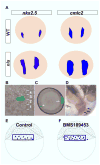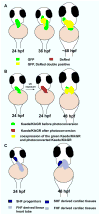Zebrafish in the study of early cardiac development
- PMID: 22427324
- PMCID: PMC3329892
- DOI: 10.1161/CIRCRESAHA.111.246504
Zebrafish in the study of early cardiac development
Abstract
Heart development is a complex process that involves cell specification and differentiation, as well as elaborate tissue morphogenesis and remodeling, to generate a functional organ. The zebrafish has emerged as a powerful model system to unravel the basic genetic, molecular, and cellular mechanisms of cardiac development and function. We summarize and discuss recent discoveries on early cardiac specification and the identification of the second heart field in zebrafish. In addition to the inductive signals regulating cardiac specification, these studies have shown that heart development also requires a repressive mechanism imposed by retinoic acid signaling to select cardiac progenitors from a multipotent population. Another recent advance in the study of early zebrafish cardiac development is the identification of the second heart field. These studies suggest that the molecular mechanisms that regulate the second heart field development are conserved between zebrafish and other vertebrates including mammals and provide insight into the evolution of the second heart field and its derivatives.
Figures


References
-
- Olson EN. A genetic blueprint for growth and development of the heart. Harvey lectures. 2002;98:41–64. - PubMed
-
- Olson EN, Schneider MD. Sizing up the heart: development redux in disease. Genes & development. 2003;17:1937–1956. - PubMed
-
- Beis D, Stainier DY. In vivo cell biology: following the zebrafish trend. Trends in cell biology. 2006;16:105–112. - PubMed
Publication types
MeSH terms
Grants and funding
LinkOut - more resources
Full Text Sources

